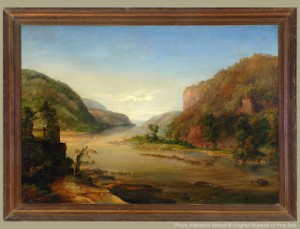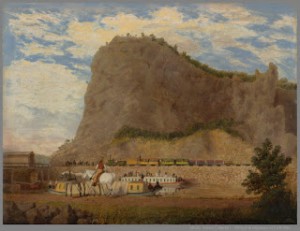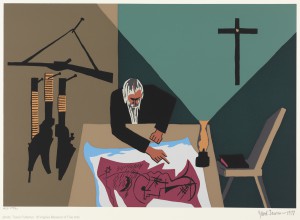
Harper’s Ferry ca.1840-50
Upon visiting Harpers Ferry in 1783, Thomas Jefferson was so awestruck by the raw beauty of the confluence of the Shenandoah and Potomac rivers that he described the view as “perhaps one of the most stupendous scenes in nature.” In addition to being a site of great natural beauty, Harpers Ferry, now situated at the junction of the state borders of Virginia, West Virginia and Maryland, also played a pivotal role in important episodes of U.S. history. This summer VMFA is fortunate to have a group of artworks on view throughout the museum that explores this special place and its unique contribution to the life of the nation.
Thanks to Jefferson’s writings, many tourists and artists from around the globe flocked to the area during the early 19th century. The work by an unidentified artist (above), now on view in the Mellon American galleries, shows a vantage point from a spot which came to be known as Jefferson’s Rock. The scene, however, is more one of picturesque tranquility than thethird president’s sublime vision.

George Harvey, Scene of the Baltimore & Ohio Railroad and the Chesapeake & Ohio Canal at Harpers Ferry, Virginia, ca 1837-40
Harpers Ferry was also an important industrial center and transportation hub. George Harvey’s painting of the Chesapeake & Ohio canal and Baltimore & Ohio railroad (above), on view in the American galleries, is one of the earliest American landscapes to depict rail travel. The town’s strategic importance made it a hotly contested site during the Civil War, and it changed hands several times. William MacLeod’s Maryland Heights: The Siege of Harpers Ferry, on view in the special Mellon Focus Galleries summer exhibition, Bold, Cautious, True, shows a panoramic view of the town as seen from a federal battery on the Maryland side of the Potomac.
Perhaps the most significant legacy of Harpers Ferry, however, was as the focal point of John Brown’s failed raid on the federal armory in 1859, the event that helped spark the Civil War. Jacob Lawrence’s The Legend of John Brown print series, which chronicles the life and death of the controversial abolitionist, is on view in the Works on Paper Focus Gallery through the end of July.

Jacob Lawrence, John Brown, after long meditation, planned to fortify himself somewhere
in the mountains of Virginia or Tennessee and, there, make raids on the surrounding plantations,
freeing slaves from the Legend of John Brown, 1977
– Corey Piper, Mellon Curatorial Associate